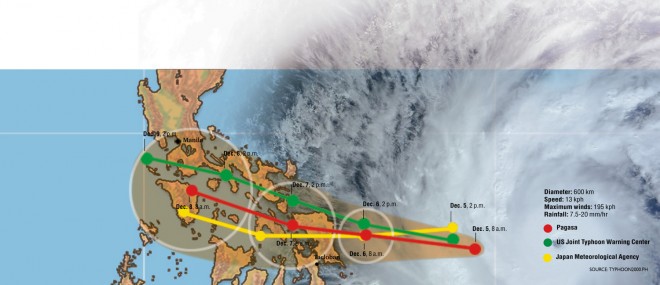Differing forecasts widen swath of typhoon ‘Ruby’s’ path

Typhoon “Hagupit” (Filipino for “smash”), locally known as “Ruby,” was expected to blast in from the Pacific Ocean into central Philippines late today, lashing parts of a region that was devastated by last year’s Supertyphoon “Yolanda” (international name: Haiyan) and left more than 7,300 people dead and missing. Still, the good news was that the typhoon was weakening as it blew closer to the coast.
Path debatable
At least 47 of the country’s 81 provinces are considered potentially at high risk from Ruby, officials said. The first one in its path is the Eastern Samar province where it will make landfall.
It is then expected to cut across central islands along a route north. But its path thereafter is debatable.
The computer models of the two agencies tracking the typhoon closely—the US military’s Joint Typhoon Warning Center in Hawaii and the Philippine weather agency—showed different tracks for the typhoon.
The US agency said Ruby may veer north after coming inland and sweep past the southern edge of the capital Manila. The Philippine agency, known by its acronym Pagasa (Philippine Atmospheric, Geophysical and Astronomical Services Administration), projected a more southern track. But both tracks appeared to be coming closer together as the landfall time approaches.
Also, both agencies said the typhoon is slowly losing strength. Pagasa said it is now packing winds of 195 kilometers (121 miles) per hour and gusts of 230 kph (143 mph).
The US center in Hawaii downgraded the typhoon’s status from a supertyphoon and said it was expected to continue losing strength with winds dropping to 175 kph (108 mph) by tomorrow morning.
Ruby’s erratic behavior prompted the government to call an emergency meeting of mayors of metropolitan Manila. Defense Secretary Voltaire Gazmin said he’d rather “overprepare than underprepare.”
Manila Mayor Joseph Estrada said authorities have alerted residents. “We are ready,” he said, but pointed out that “these typhoons change direction all the time.”
Dr. Steven Godby, an expert in natural hazards at Nottingham Trent University in Nottingham, said the Philippines experiences five to 10 cyclones a year on an average, the most hitting any country.
He said the right oceanic conditions to create deadly typhoons “come together in the western Pacific and put the Philippines in the firing line as a result.”
Cyclones also need a force “to give them an initial rotation and this is provided by the spin of the Earth through the Coriolis force, but in a narrow ‘sweet spot’ of between 5-12 degrees north and south of the equator,” he said.
“Isolated island groups like the Philippines are particularly vulnerable to tropical cyclones and the threats come from the high winds, storm surge and heavy rains these storms bring,” he said. AP